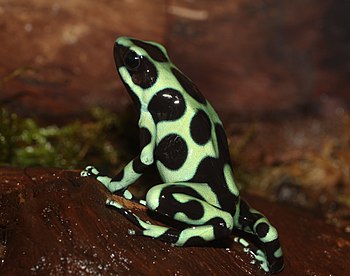Some people mistakenly believe that reptiles and amphibians are one and the same or they simply do not know how to tell the difference. Amphibians are born as soft eggs in water and then hatch into tadpoles. Living out the start of their life in the water they then grow legs, lose their tails, and become frogs.
On the other hand reptiles are born as shelled eggs laid on land and hatch as a smaller version of what they will eventually become at maturity. Reptiles never morph into a new form as do amphibians. There is another way of telling the difference between an amphibian and a reptile: reptiles are capable of living in dry areas whereas amphibians cannot.
 |
| Red-eyed Tree Frog near Las Horquetas, Costa Rica (Photo credit: Wikipedia) |
Belize has many tree dwellers with the Red-Eyed Tree Frog being unique and definitely the most interesting. This beautiful green frog has extremely large bright red eyes, hence its' name. Agalychnis callidryas is the scientific name for this fascinating little creature. The Red-Eyed Tree Frog has a medium bright to dark green body with yellow and blue striped type of markings on both of its' sides and sports deep orange toes. Exact coloration of these tree dwellers varies from frog to frog and region to region. Despite the bright warning like colors the fogs are not poisonous, though the reason for their flamboyant coloring is unknown. As tadpoles, after hatching, the babies are brownish in color and will become green, a coloration they can change slightly depending on mood and environment, as they mature into adult frogs living as long as 5 to 10 years.
During the day Tree Frogs will stay put without moving at all, unless disturbed. By shutting their eyes, covering their blue sides with their back legs and tucking in their bright orange feet under their belly, they then look like green leaves, and are well hidden in their jungle habitat.
As with a good number of frogs the females are larger than the males. The average female is approximately two and one half to three inches long while the average male is about one half an inch smaller.
The Red-Eyed Tree Frog has three eyelids and sticky pads on its toes. The sticky pads help them to be arboreal or animals that spend a great majority of their lives in the trees. Tree Frogs are very good jumpers which they need to be to move from tree to tree.
Eating crickets, moths, flies, and other insects makes the Tree Frog classed as a carnivorous species, even cannibalistic, as they have been known to eat other small frogs. Due to their diet and life cycle Tree Frogs are almost always found near rivers, streams, ponds, lagoons and other waterways throughout the jungle from Mexico to Columbia, South America.
Chorus Frogs are closely related to Red-Eyed Tree Frogs, both of which share the same body style and many of the same habits. However Chorus Frogs are more vocal, Tree Frogs are only most vocal during mating time in the rainy reason.
As previously stated: Unlike amphibians, reptiles are capable of living in dry areas. The fact that the Red-Eyed Tree Frog lives in trees, that are sometimes found in dry areas, makes this little amphibian a truly unique little creature.
Anthony Benjamin, an avid writer, world traveler and a great lover of nature. He would like for you to check-out his latest book: http://www.amazon.com/Belize-Wildlife-Barrier-Fishing-ebook/dp/B007E2SFNQ/ref=sr_1_1?ie=UTF8&qid=1336140932&sr=8-1 Article Source: EzineArticles |







